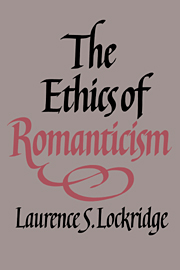Book contents
- Frontmatter
- Contents
- Acknowledgments
- Editions and abbreviations
- Introduction
- PART ONE THE WILL TO VALUE
- PART TWO AGENT, POWER, SCENE
- PART THREE THE PRESSURE OF REALITY
- 6 Shelley and the poetry of life
- 7 Hazlitt: common sense of a dissenter
- 8 Keats and the ethics of immanence
- 9 Byron: the world as glorious blunder
- 10 The ethical bearing of literature
- Select bibliography
- Index
6 - Shelley and the poetry of life
Published online by Cambridge University Press: 16 September 2009
- Frontmatter
- Contents
- Acknowledgments
- Editions and abbreviations
- Introduction
- PART ONE THE WILL TO VALUE
- PART TWO AGENT, POWER, SCENE
- PART THREE THE PRESSURE OF REALITY
- 6 Shelley and the poetry of life
- 7 Hazlitt: common sense of a dissenter
- 8 Keats and the ethics of immanence
- 9 Byron: the world as glorious blunder
- 10 The ethical bearing of literature
- Select bibliography
- Index
Summary
Coleridge and Shelley invite the easy censure that they contradict, in the patterns of their lives, the moral ideas they espouse, Coleridge in acts of omission that imperil mostly himself, and Shelley in callous, willful acts that scandalize and kill. In Alastor the Poet rejects a loving Arab maiden, “wildered, and wan, and panting,” to pursue a “Veiled maid” whose “voice was like the voice of his own soul,” and who eludes him to the end. Similarly, Harriet Shelley, Elizabeth Hitchener, and Mary Shelley are deserted by a poet crazed by other lights, whether other women, like Claire Clairmont, Teresa Viviani, and Jane Williams, or whether some nameless, relentlessly beckoning horizon of possibility. His self-absorption, projected outward in an undefined and ceaseless pursuit, ostensibly destroys his wife Harriet, his children, Clara and William, and later his two shipmates;, Edward Williams and Charles Vivian, in that final suicidal attempt to run out a gale in the Gulf of Spezia.
This easily propounded paradox, in which there is a measure of truth, can obscure those gestures of gentleness and passionate resolve where Shelley acts coherently. It can also reduce this complex vision itself to what I term moral bombast, adapting a phrase from Coleridge. Shelley speaks of “beautiful idealisms of moral excellence” with suspect high-mindedness, as in his letters to Elizabeth Hitchener. One could fill a volume with peevish illustration that he does not reck his own rede.
- Type
- Chapter
- Information
- The Ethics of Romanticism , pp. 281 - 332Publisher: Cambridge University PressPrint publication year: 1989

